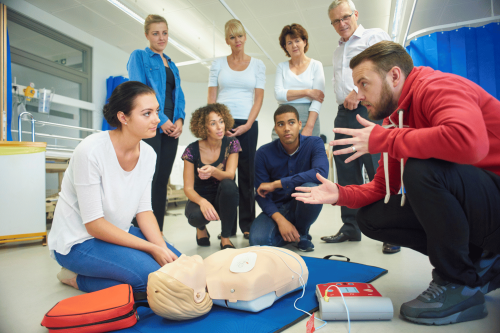
Quick Summary: Key Takeaways
- What is Respiratory Rate (RR)? The number of breaths per minute, reflecting the body’s oxygen demand and carbon dioxide elimination.
- Why It Matters: Abnormal RR can signal medical emergencies like sepsis or cardiac arrest before other symptoms appear.
- Normal Ranges: Vary by age, with adults typically at 12–20 BPM and newborns at 30–60 BPM.
- Measurement Methods: Manual counting, electronic monitoring (e.g., pulse oximeters, capnography), and wearable devices (e.g., Apple Watch, Garmin).
- When to Worry: Seek medical attention if RR exceeds 24 BPM or drops below 10 BPM at rest, or if breathing is painful or irregular.
Why Respiratory Rate Matters?
Breathing is so automatic that most people never think about it—until something feels wrong. Yet, respiratory rate (RR), the number of breaths taken per minute, is one of medicine's most critical yet underappreciated vital signs.
Unlike heart rate or blood pressure, which are frequently tracked, respiratory rate is often measured manually, making it prone to oversight. However, research shows abnormal respiratory rates can signal medical emergencies before other symptoms appear. For instance, a study published in BMJ Open found that tachypnea (rapid breathing) is a stronger predictor of cardiac arrest than abnormal heart rates.
Whether you're a healthcare professional, athlete, or simply health-conscious, understanding normal respiratory rates—and what alters them—can help detect early signs of illness, optimize fitness, and even save lives.
Methods of Measurement
Respiratory rate can be measured using various methods, each suited to different contexts. Here’s an overview:
-
Manual Counting This traditional method involves observing chest rises for 30 seconds and multiplying by 2 (or counting for a full 60 seconds for greater accuracy). It’s simple, cost-effective, and ideal for at-home checks or clinical settings without monitors. However, it relies heavily on the observer’s attention and consistency, which can introduce variability.
-
Electronic Monitoring In more advanced settings, electronic tools provide automated and precise measurements.
- Pulse oximeters (SpO₂ devices): Estimate RR by detecting subtle changes in blood flow.
- Capnography: Used in hospitals, it measures exhaled CO₂ to calculate breath rate. These methods are beneficial for continuous monitoring in critical care.
-
Wearable Devices Fitness trackers like the Apple Watch, Garmin, and Fitbit estimate RR using motion sensors and algorithms. While convenient for everyday health tracking, they may lack the precision required for clinical diagnoses.
Why Accuracy Matters: Accurate measurement is crucial. A discrepancy of just ±2 breaths per minute (BPM) can misclassify a patient’s condition, potentially delaying treatment. For example, false lows caused by shallow breathing might mask signs of respiratory distress.
Normal Respiratory Rate by Age Group
Respiratory rates vary significantly by age due to differences in lung capacity, metabolism, and oxygen needs. Below are the accepted medical ranges:
| Age Group | Normal Range (BPM) | Key Notes |
|---|---|---|
| Newborns (0–1 month) | 30–60 | Fast due to underdeveloped lungs. |
| Infants (1–12 months) | 24–40 | Gradually slows as lungs mature. |
| Toddlers (1–3 years) | 20–30 | Active metabolism drives higher rates. |
| Children (4–12 years) | 15–25 | Nearing adult-like patterns. |
| Adolescents & Adults | 12–20 | Baseline for healthy individuals. |
| Elderly Adults | 12–18 | May increase slightly due to age-related changes. |
Exceptions & Variations:
- Athletes: Resting RR as low as 8–10 BPM due to superior lung efficiency.
- Sedentary individuals: May trend toward the higher end (18–20 BPM).
- Sleep: Reduces RR by ~2–4 BPM, with deeper phases slowing breathing further.
When to Worry: Abnormal Respiratory Rates
Deviations from normal ranges can indicate acute or chronic health issues. Here’s what to watch for:
1. Tachypnea (Rapid Breathing) – >20 BPM in Adults
- Common Causes:
- Infections (e.g., pneumonia, COVID-19, sepsis).
- Metabolic acidosis (e.g., diabetic ketoacidosis, kidney failure).
- Pain or anxiety (e.g., sharp chest pain, panic attacks).
- Red Flags:
- RR > 24 BPM at rest → High risk of respiratory failure.
- Flaring nostrils, wheezing, or gasping → Seek emergency care.
2. Bradypnea (Slow Breathing) – <12 BPM in Adults
- Common Causes:
- Drug overdose (e.g., opioids, sedatives).
- Hypothyroidism (slowed metabolism).
- Brain injury (e.g., stroke, increased intracranial pressure).
- Red Flags:
- RR < 8 BPM → Risk of oxygen deprivation (hypoxia).
- Confusion or blue lips (cyanosis) → Medical emergency.
3. Irregular Breathing Patterns
| Pattern | Description | Associated Conditions |
|---|---|---|
| Cheyne-Stokes | Alternating deep/shallow breaths. | Heart failure, brain damage. |
| Kussmaul | Deep, labored breathing. | Diabetic ketoacidosis. |
| Biot’s | Erratic, unpredictable breaths. | Severe brainstem injury. |
Factors That Influence Respiratory Rate
Respiratory rate can be affected by factors beyond illness. Here are some key factors to consider:- Exercise: Intense activity temporarily increases RR (e.g., 40–60 BPM), while regular aerobic training lowers resting RR.
- Stress & Emotions: Anxiety can cause hyperventilation, while relaxation techniques like meditation slow breathing.
- Environment: High altitudes (low oxygen) and air pollution can increase RR.
- Medications: Opioids depress breathing, while stimulants like caffeine may slightly increase it.
- Chronic Conditions: COPD, asthma, and obesity often lead to higher RR.
- Pain & Trauma: Injuries like rib fractures can cause shallow, guarded breathing.
FAQ: Common Questions About Respiratory Rate
Q: Can anxiety alone cause a high respiratory rate?
A: Yes. Acute stress can trigger hyperventilation (20+ BPM), but it should normalize once you relax. Chronic anxiety, however, may lead to habitual over-breathing.Q: When should I go to the ER for breathing problems?
A: Seek immediate medical attention if:
- Your respiratory rate is greater than 24 BPM or less than 10 BPM at rest.
- Breathing is painful or accompanied by dizziness or confusion.
Q: Does sleep apnea affect respiratory rate?
A: Yes. Pauses in breathing (apneas) disrupt normal respiratory rates. Common symptoms include snoring, daytime fatigue, and abrupt awakenings gasping for air.Q: Can dehydration affect breathing?
A: Indirectly. Severe dehydration can thicken mucus, increasing airway resistance, which leads to faster, harder breathing.The Bottom Line: Why Monitoring Respiration Matters
Respiratory rate isn’t just a number—it’s a real-time snapshot of your body’s metabolic and physiological state. From detecting early signs of sepsis to optimizing athletic performance, tracking RR provides actionable insights that can make a significant difference in your health.
Take Action:
- At-Home Monitoring: Check your RR at rest 2–3 times weekly, especially if you’re managing a lung or heart condition.
- Leverage Technology: Use wearable devices like the Apple Watch, Garmin, or Fitbit to track trends over time. Apps such as Welltory or MyFitnessPal can also help you monitor and interpret your respiratory data.
- Seek Medical Advice: If you notice abnormal patterns, such as sudden increases or consistently irregular rates, consult a healthcare professional promptly.
By understanding what drives each breath and using the right tools to monitor it, you gain a decisive advantage in health awareness. Early intervention can save lives—start tracking today to stay ahead of potential issues.








 Login with Google
Login with Google Login with Facebook
Login with Facebook